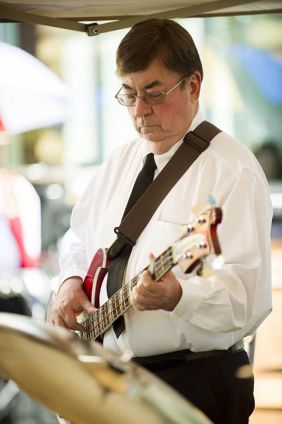Since then a Beatles Tribute band, "1964 The Tribute" contacted me and asked to borrow my replica tam for a film clip they were making. So I overnighted it to the drummer, Robert Potter, in Florida. He wore it in the film and sent it back; the band thanked me in the film's credits. This was an honor for sure, as 1964 the Tribute has been called the very best Beatles Tribute band by Rolling Stone magazine, and they have played in Carnegie Hall eight times, which is not exactly the venue for amateur musicians.
See the New Covid 19 64 Stay at Home Video linked at their website that shows Bob Potter ("Ringo") wearing my tam and playing drums. The band looks so much like the real Beatles and sound so much like the real Beatles that it is positively uncanny. I saw the real Beatles in concert twice, in 1964 and 1965, at the Cow Palace near San Francisco (I'm old but at least I got to see the Beatles). So I know of what I speak. 1964 the Tribute's performance possesses all the excitement and magic of the original.
If you read my 2013 article, linked above, check out the comments. An anonymous reader wrote this:
The hat worn by Ringo in the making of the film help belonged to Corporal Greenhill of B Company the 1st Battalion the Royal Scots (The Royal Regiment). The hat is a Tam O Shanter (TOS) of the 1960-70 pattern. The badge is that of the Lowland Brigade as worn by Lowland Scottish Regiments of that time. The tartan patch is Hunting Stewart as worn by the Royal Scots. It is worn with the badge over the left ear.
The Filming of this part of the film took place on Salisbury Plain Training area and was supported by Regiments that were stationed nearby.
The hat was signed by the Beatles before handing back to Cpl Greenhill who continued to wear it as normal; subsequent washing got rid of the signatures.
What a lovely piece of film and music history. I’m David Greenhill’s granddaughter and the hat is still kept safe by his sister - a huge Beatles fan herself! It was signed by each of the Fab Four after filming for the day.
It’s always a fun bit of trivia whenever the film plays on the tv.
December 22, 2022 at 10:14 AM
One final word about Bobby Potter who portrays Ringo in the band's performances: in a fairly recent concert, Ringo was in the audience and posed for a picture with Bobby, both with their arms around each other's shoulder and looking at each other with huge grins. I will post that picture when I can find it again. It' s been a year or two.









